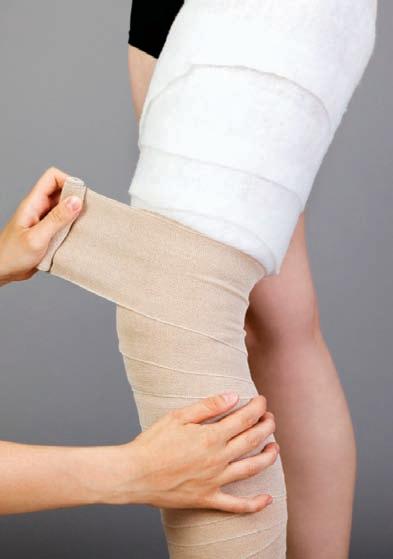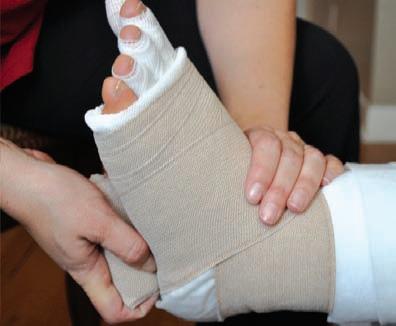Prescribing Compression Garments for Lymphostatic and Venous Edemas
By Angela VollmerLymphostatic and venous edemas of the extremities are progressive conditions. Untreated, there is proliferation of connective tissue, fibrosis and sclerosis, making it important to commence conservative longterm treatment at an early stage. Once the edema is reduced with an intensive period of manual lymphatic drainage and bandaging, the patient is ready to be fitted with compression garments and to continue with skin care to avoid infection, and specific exercises. The prescription of medical compression requires a working relationshipbetween the patient, physician, lymphedema therapist and garment fitter. Compression garments increase interstitial tissue pressure thus reducing new influx of fluid into the interstitial space. They also help stimulate lymphatic vessel s through enhancement of muscle pump action. A compression stocking is made-to-measure for the patient after an intensive decongestion period of four to six weeks. Use of the correct compression stockings for lymphedema is an essential prerequisite for adequate results in long-term therapy. The choice of compression class, stocking material, application of a dressing (where required) and possible combinations (such as wearing two compression stockings on top of one another) requires a great deal of experience on the part of lymphedema therapist and the attending physician. In general, the required compressive force and type of stocking depend on the type,


severity and location of the lymphatic edema, as well as on the age of the patient. Such secondary disorders as radiogenic damage or rheumatic disorders must also be taken into account when prescribing treatment. The thicker, custom-made flat-knitted seamed stockings are ideal for dressing massive lymphatic edemas. These stockings
Angela Vollmer has a Masters of Orthopaedic technology in Germany and has over 20 years experience working in the lymphedema clinics of Dr. Földi and Dr. Asdonk, providing approximately 2,500 custom made compression garments per year. Ms Vollmer teaches seminars to garmentfitters and orthopaedic technicians in Switzerland, Italy, France and Canada focusing on measuring technology and compressions garments for all types of lymphedema.
do not chafe or constrict the vessels and are highly air permeable. The stockings can be manufactured to exactly the specified dimensions. The more attractive thin, seamless, circular-knit stockings very often constitute a compromise when treating lymphedema but may be less effective.
Primary lymphedema
Inprimary lymphedema there is impaired lymph flow an accumulation of proteinrich liquid in the interstitial fluid as a result of congenital dysplasia of the lymphatic system. In general, these patients require a higher degree of compression. In stage I primary lymphedema, the extremity concerned can be treated with a stocking of compression class II (see editor’s note, page 19*), using either seamless grades or large-mesh seamed stockings. Compression class III in the form of a seamless or preferably largemesh seamed stocking is used for stage II. A high compressive force must be applied in the case of stage III (lymphostatic elephantiasis) with extensive tissue deformities and skin changes. Here compression class IV or possibly even two stockings are required in order to obtain the necessary compressive force. An additional knee-high compression stocking may be needed in order to achieve the required compressive force if the edema has a strong distal tendency. A toe cap is usually also fitted to prevent edema in the toes. The application of two stockings does not mean that the compressive force is doubled: combining a compression

stocking of class III with compression hosiery of class III yields pressure values corresponding roughly to class IV but not the equivalent of class VI.
Secondary lymphedema of the arm
The most commonly found form of secondary lymphedema is in the arm following surgery for breast cancer. The edema is aggravated by the post-operative radiotherapy treatment to the regional lymphatic nodes which is normally required after such surgery.
Treatment with an arm sleeve follows the same principles as in the case of primary lymphedema. The compression must meet the specific requirements of the patient’s lymphedema location, stage and severity and may require one of various possible combinations of components (e.g. supporting arm sleeve with or without shoulder cap; gauntlet—without fingers, or open glove with fingers). The garments should always be measured and produced to the size
present after maximum decongestion, after the initial intensive phase of lymphedema treatment. Compression class II is normally used, apart from a few exceptions (such as radiogenic damage to the nerves, restricted movement due to secondary disorders, older or very thin patients) where class I may be better tolerated.


Phleboid edemas
The venous and lymphatic circulation are closely interrelated. For example, venous decompensation increases the lymphatic water and protein load and therefore increases the burden on the lymphatic system. The body compensates for this additional burden by exploiting lymphatic vessel functional reserves, but the prime therapeutic objective is to enhance the venous circulation in order to avoid manifest damage to the lymphatic system. Depending on the degree of the edema, the first step in







therapy may be to apply compression bandages or to go through a period of combined physical decongestion therapy followed by the application of compression hosiery. Standard, circular knit stockings of class I or II may be adequate in mild cases.
continued on page 18








Compression garments increase interstitial tissue pressure thus reducing new influx of fluid into the interstitial space.

Phlebolymphatic edema
This refers to an edema of the extremities with lymphatic vessel damage secondary to longstanding chronic venous insufficiency (CVI). The venous insufficiency can be due to thrombosis (post-thrombotic syndrome), pronounced varicose vein insufficiency, or malformed valves or veins. The lymph vessels are ultimately damaged after years of trying to compensate for venous edema and the increased lymphatic water and protein load. Lymphedema appears when the functional reserve of the lymphatic system is exhausted. Patients with phlebolymphatic edema must have consistent, usually life-long follow-up and decongestive therapy for their lymphostasis. This includes the
use of a compression stocking usually of class II, following intensive reduction of the lymphatic edema as detailed above. Made-to-measure, flat-knit stockings are usually required for treating venous edemas of the extremities if lymphatic damage also exists.
Lipedema syndrome
Lipedema is a chronically progressive disorder with symmetrically disturbed distribution of fatty tissue, mostly on the thighs and hips, combined with tenderness, easy bruising and an orthostatic tendency to foot edema. It is almost exclusively seen in women. Lipolymphedema is a combination of disturbed distribution of fatty tissue and secondary damage to the lymphatic system. Lymphatic drainage is normally not required for a pure stage I lipedema, i.e. where there is no edema or other signs of lymphostasis. Consistent compression therapy with medical compression hosiery of class II is sufficient here. The volume









